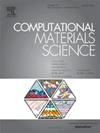基于金属物理的塑性冷加工对声弹效应影响预测模型
IF 3.3
3区 材料科学
Q2 MATERIALS SCIENCE, MULTIDISCIPLINARY
引用次数: 0
摘要
超声技术是材料研究和工业应用中至关重要的无损检测方法,广泛用于检测气孔和裂纹等缺陷,通过声弹性效应测量残余应力,以及测定金属表面粗糙度和位错密度。在Hughes和Kelly的声弹性理论的基础上,扩展了Murnaghan的非线性弹性理论,本研究探讨了与塑性冷加工变形状态有关的超声波传播速度。包括Taylor方程和Kocks-Mecking模型在内的关键模型描述了位错密度与宏观力学性能之间的关系,阐明了塑性变形的影响。本文主要研究了塑性变形对超声波传播速度和声弹性常数的影响。结合理论模型和实验数据,建立了声弹性常数作为塑性应变函数的数学框架。该研究利用实验数据验证了这些模型,强调了波速变化与塑性应变之间的二次关系。研究结果强调了声弹性常数对微观结构变化的敏感性,为工业应用中监测和分析材料性能提供了有价值的见解。本文章由计算机程序翻译,如有差异,请以英文原文为准。

Metal physics based model for predicting the influence of plastic cold-working on the acoustoelastic effect
Ultrasonic technology is a crucial non-destructive testing method in materials research and industry applications, widely used for detecting defects like pores and cracks, measuring residual stresses via the acoustoelastic effect, and determining surface roughness and dislocation density in metals. Building on Hughes and Kelly’s acoustoelasticity theory, which extends Murnaghan’s non-linear elasticity theory, this study investigates the propagation velocity of ultrasonic waves in relation to an plastic cold-working deformation state. Key models, including the Taylor equation and the Kocks–Mecking model, describe the relationship between dislocation density and macroscopic mechanical properties, elucidating the effects of plastic deformation. This research focuses on the impact of plastic deformation on the propagation velocity of ultrasonic waves and the acoustoelastic constant. By integrating theoretical models and experimental data, it establishes a mathematical framework for the acoustoelastic constant as a function of plastic strain. The study validates these models using experimental data, highlighting a quadratic relationship between wave velocity changes and plastic strain. The findings underscore the sensitivity of acoustoelastic constant to microstructural changes, offering valuable insights for monitoring and analysing material properties in industrial applications.
求助全文
通过发布文献求助,成功后即可免费获取论文全文。
去求助
来源期刊

Computational Materials Science
工程技术-材料科学:综合
CiteScore
6.50
自引率
6.10%
发文量
665
审稿时长
26 days
期刊介绍:
The goal of Computational Materials Science is to report on results that provide new or unique insights into, or significantly expand our understanding of, the properties of materials or phenomena associated with their design, synthesis, processing, characterization, and utilization. To be relevant to the journal, the results should be applied or applicable to specific material systems that are discussed within the submission.
 求助内容:
求助内容: 应助结果提醒方式:
应助结果提醒方式:


